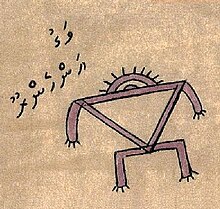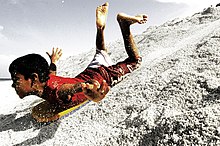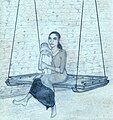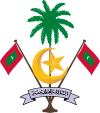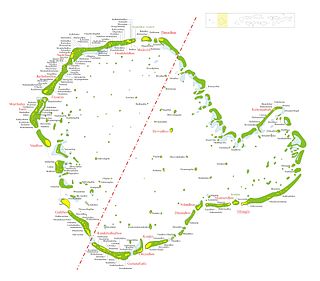
Huvadhu, Suvadive, Suvaidu or Suvadiva is the atoll with the most islands in the world. The atoll is located in the Indian Ocean. It is south of the Suvadiva Channel in the Republic of Maldives with a total area of 3,152 km2, of which 38.5 km2 is dry land. The atoll contains 255 islands.

Gnaviyani Atoll is one of the administrative divisions of the Maldives corresponding to the natural atoll, Fuvahmulah. Surfacewise this is the smallest administrative unit in the Maldives, situated on the Equatorial Channel between Huvadhu Atoll and Addu Atoll.
Fiyoaree or Fiori is one of the inhabited islands of Gaafu Dhaalu Atoll, Maldives.
Vaadhoo is an inhabited island of Gaafu Dhaalu region in the atoll of Huvadhu, Maldives. It has its own dialect of Maldivian, which is considerably different from northern and Mid-Maldivian speech.
Dhevvadhoo or Devvadū is one of the inhabited islands of the administrative division known as Northern Huvadhu Atoll.
Dhanbidhoo or Dambidū is one of the inhabited islands of Haddummati Atoll, administrative code Laamu.

Isdhoo or Isdū is one of the inhabited islands of Haddhunmathi Atoll, administrative code Laamu part of Maldives in the Indian Ocean.

Thoddoo is one of the inhabited islands of Alif Alif Atoll in the Republic of Maldives.
Thuraakunu is the northernmost island in Maldives, one of the fourteen inhabited islands of Haa Alif Atoll and is geographically part of the Ihavandhippolhu Atoll in the Maldives. It is an island-level administrative constituency governed by the Thuraakunu Island Council.
Several Dhivehi scripts have been used by Maldivians during their history. The early Dhivehi scripts fell into the abugida category, while the more recent Thaana has characteristics of both an abugida and a true alphabet. An ancient form of Nagari script, as well as the Arabic and Devanagari scripts, have also been extensively used in the Maldives, but with a more restricted function. Latin was official only during a very brief period of the Islands' history.
Maldivian mythology or Maldivian folklore is the body of myths, tales and anecdotes belonging to the oral tradition of Maldivians. Even though some of the Maldivian myths were already mentioned briefly by British commissioner in Ceylon HCP Bell towards the end of the 19th century, their study and publication were carried out only quite recently by Spanish writer and artist Xavier Romero-Frias, at a time when that ancestral worldview was quickly disappearing.

Maldives fish is cured tuna traditionally produced in Maldives. It is a staple of the Maldivian cuisine, Sri Lankan cuisine, and the cuisine of the Southern Indian states and territories of Lakshadweep, Kerala and Tamil Nadu, and in the past it was one of the main exports from Maldives to Sri Lanka, where it is known as umbalakaḍa (උම්බලකඩ) in Sinhala and masikaruvadu in Tamil. It is also produced in small scale using traditional methods in Lakshadweep Islands in India. It is known as massmin in Lakshadweep.
Dhivehi Latin or Maldivian Latin, known colloquially as Malé Latin or Nasiri Latin, is a Latin Maldivian alphabet briefly mandated in the Maldives from 1976, but the country reverted to the native Thaana and Arabic alphabets in 1978. Maldivian Latin is still widely used in non-academic literature for romanizing Maldivian, however its rules are not strictly adhered to by most Maldivians.

Buddhism was the predominant religion in the Maldives until at least the 12th century CE. It isn't clear how and when Buddhism was introduced into the islands.

Maldivians are an Indo-Aryan ethnic group and nation native to the historic region of the Maldive Islands, present day Republic of Maldives and the island of Minicoy in Union Territory of Lakshadweep, India. Maldivians share one culture and speak the Maldivian language, which is a member of the southern group of Indo-Aryan languages. For ethnographic and linguistic purposes as well as geopolitical reasons, anthropologists divide the Maldivian people into three subgroups.
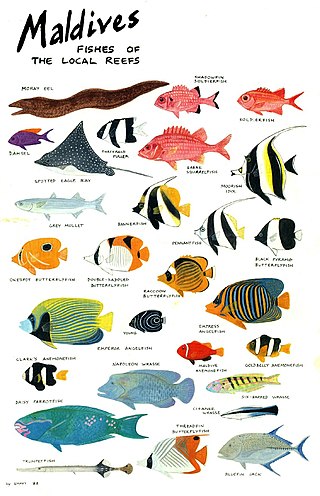
Xavier Romero Frías is a Spanish writer and scholar. He lived among the Maldivians over a 13-year period. His present residence is in Bangkok, Thailand.

Dhivehi or Divehi, is an Indo-Aryan language spoken in the South Asian island country of Maldives and on Minicoy Island, Lakshadweep, a union territory of India.
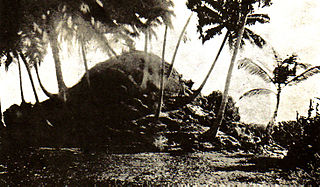
Fua Mulaku Havitta is the ruin of a Buddhist chaitya whose main feature is its ruined stupa. The Havitta is located at the northeastern end of Fuvahmulah, Maldives. It was historically located in Dhadimagu ward of the island, in an area which has now been annexed to Hoadhadu ward. Being the most important center of the Buddhist community in the pre-Islamic period, Dhadimagu was the last ward of the island to have accepted Islam. It was after the acceptance of Islam by the residents of Dhadimagu ward that the Havitta was buried under a mound of sand and one of the temples in the area was converted into a mosque to be known as Gemmiskiy. This happened in the early 1200s under the leadership of Abu Bakr Naib, who completed the conversion process in Fuvahmulah started by his great grandfather Yoosuf Naib in the year 1145 CE.

Launaea sarmentosa is a perennial herb species in the family Asteraceae. It is native to coastal areas in Africa, Madagascar, the Seychelles, Mauritius, India, Sri Lanka, Maldives and Southeast Asia. It is naturalized in Western Australia.

Gulha is a typical and popular Maldivian short eat.

